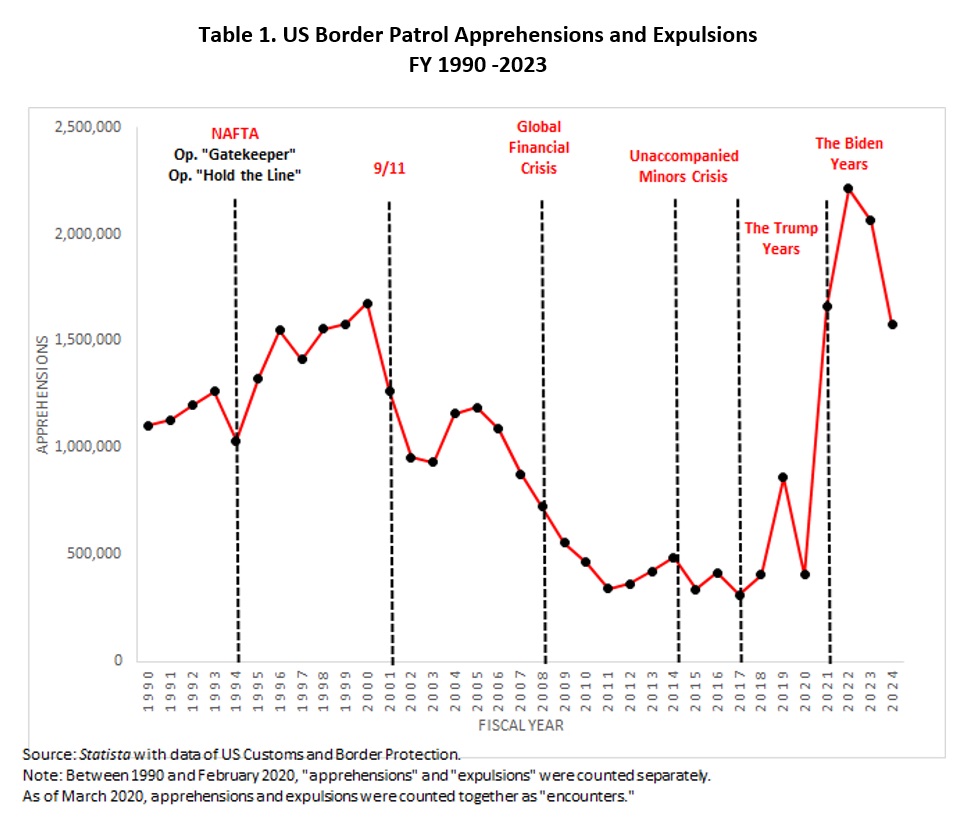Addressing the US Immigration Crisis in the Era of “America First”

Guadalupe Correa-Cabrera provides policy recommendations to address the (im)migration crisis in the United States and proposes a long-term comprehensive solution.
Immigration is one of the most important issues in US politics and elections today. A majority of US adults want immigration levels reduced, but US public opinion is intensely polarized around this topic. There is substantive misinformation and disinformation regarding the real economic and social effects of unauthorized and irregular immigration (1). US immigration and asylum systems are broken. Current immigration policies deepen homeland security risks and human security problems related to irregular migration or unauthorized immigration and have had unintended negative consequences for the US economy and society.
To address these issues and renovate the failing US immigration and asylum systems, the complexities of the US bound migration phenomenon, as well as irregular migration dilemmas in the Americas and beyond, must be better understood. “New” US immigration policies and Trump’s executive orders in his second administration related to this topic will very plausibly make things worse. Mass deportations, sending US and Mexican troops to the border, and proposals to end birthright citizenship will not resolve the social and economic problems America faces today.
In this op-ed, I explain current trends in US bound irregular migration and unauthorized immigration, and provide policy recommendations to address the so-called immigration crisis and comprehensively fix the current immigration system in America.
US bound migration trends today
US bound migration has rapidly transformed over the past two decades. Both the composition of mass migrations and number of migrants traveling irregularly and entering the United States without authorization, or applying for asylum, have changed significantly. These variations reflect US border enforcement and immigration policies, as well as deteriorating socioeconomic, political, security and environmental conditions in their countries of origin. During the past few years, an increasing number of migrants and asylum seekers from different parts of the Western Hemisphere—and other regions of the world (including the Middle East, Eastern Europe, China, and several countries of South and Southeast Asia, as well as the African continent)—have been undertaking a long and perilous journey to the United States. Families, women, and unaccompanied minors make up a larger share of those emigrating to the United States today compared with a century ago when migration flows were dominated by young adult males.
The routes and means of transportation for US bound migration movements have also changed radically in recent years. Due to the lack of regular routes or legal migration pathways for displaced people from countries experiencing economic, social, and/or political crises, armed conflict or war, mobilization from these zones to the United States tends to occur in an irregular or illicit manner. Human mobility has thus been facilitated by extremely sophisticated migrant smuggling networks that operate sometimes in tandem with criminal organizations, other illicit networks, and corrupt officials. Hence, there are homeland security risks associated with current migration patterns and organized mass migrations from specific regions of the world.
Trends in US bound irregular migration have registered cycles related to several factors, including economic crises, political instability, armed conflicts, and specific socioeconomic conditions in different parts of the world. US border enforcement and immigration policies have had the greatest impact on such trends, which can be captured—to some extent—by the number of US Border Patrol apprehensions and expulsions.

Explaining US bound irregular migration and unauthorized immigration
Understanding the changing trends in terms of size, evolution, and routes of US bound irregular migration and unauthorized immigration is key for implementing more appropriate immigration policies at the national, hemispheric, and global levels, and for resolving issues related to undocumented immigration and better securing the US-Mexico border. In fact, US bound irregular migration movements and unauthorized immigration have multifactorial explanations. There are “pull” and “push” factors that explain current human mobility patterns. The push factors of irregular or unauthorized immigration are related to economic or political crises, limited access to basic services, violence and insecurity, environmental degradation, and climate change, among others.
On the other hand, pull factors—the ones that attract irregular and unauthorized migrants to the United States and other developed countries—are mainly related with having access to jobs, availability of economic opportunities, family reunification, and a series of human mobility facilitators (including human smugglers). The pull factors of unauthorized or irregular migration in the Americas are extremely relevant but have received less attention than the push factors, which have attracted more attention. Human smuggling needs to be taken more seriously considering its growing influence and expanded capacity.
Enhanced security along the US-Mexico border, greater immigration enforcement within Mexico and at its southern border in the past few years, as well as a considerable expansion of migrant routes globally have made migrant smuggling more complex and lucrative. At the same time, the criminal and migrant landscape has become much more dangerous and international migrant smuggling networks have played an ever-greater role. Technology and new communications have facilitated and contributed to the expansion of such activities. The business model explaining migrant smuggling networks has seemingly changed as well, in the context of more sophisticated social media platforms and digital financial services.
Considering the multiple factors and dimensions that explain the complexity of US bound irregular migration and issues of unauthorized immigration, successful policies must be comprehensive and address all facets of the problem. However, as observed in a Council on Foreign Relations (CFR) article, the US Congress has repeatedly disagreed on immigration measures and reform overall, “effectively moving some major policy decisions into the executive and judicial branches of government and fueling debate in the halls of state and municipal governments.”
In this context, a long-term comprehensive solution needs to be agreed upon by all branches of government. They might consider the following recommendations that require unity and consensus, as well as a serious effort to alleviate polarization around this key issue.
Recommendations
-
The US government should cooperate with other governments to address the root causes of irregular and unauthorized (im)migration.
An overall effective strategy to address the main issues related to unauthorized or irregular (im)migration should focus on tackling its root causes, that is, extreme poverty, excessive income disparities, lack of economic opportunities, social and political violence, impunity, and corruption, among others. Focusing on Central America is not enough; specific actions and collaboration should take place regionally and beyond. It is particularly relevant and urgent to determine concrete measures to address these root causes, assign specific budgets for this purpose in different regions and countries, and implement the required tasks to solve these structural issues. The US government and the private sector should coordinate their activities, and remain in constant communication to ensure effective collaboration and transparency.
-
A human security strategy to address issues related to US bound irregular and unauthorized migration should be complemented with the provisions of legal migration pathways for low-skilled workers in the United States.
A more effective homeland security approach to US bound irregular migration or US unauthorized immigration should be accompanied by a human security strategy and immigration reform that incorporates legal migration pathways for low-skilled workers and other immigrants whose activities and capabilities are essential for the US economy. A substantial increase in the number of temporary visas for unskilled workers would be a positive step forward, but additional actions are needed—such as the adjustment of status for the current undocumented population, a comprehensive repair of the asylum system, and a rational operational control of the border, among other measures. The US immigration system has countless limitations that can only be solved through the passage of bipartisan comprehensive immigration reform.
-
To protect human security along the migration routes and prevent homeland security risks, the US government should focus on dismantling migrant smuggling networks through intelligence and targeted actions.
The dismantling of migrant smuggling networks through intelligence and targeted actions are important elements both for strengthening border security and enforcement, as well as humanitarian migration management. These actions should include: 1) identifying migrant smuggling networks as a subset of transnational crime; 2) allocating resources to enable the collection of intelligence and financial information of these networks; 3) developing a “whole-of-government” strategy, as well as a regional strategy to counter human smuggling networks; 4) strengthening law enforcement capacity to dismantle specific smuggling organizations; and 5) reforming the asylum system, which was not designed for current migration flows and is being exploited—in other words, the US asylum system should be adjusted to reflect current migration realities (2).
-
The US government should collaborate closely with other governments to solve the regional migration crisis.
As implied above, the US government should collaborate closely with other governments to gather enough information to detect, understand, and then dismantle migrant smuggling networks. It should also collaborate closely with other governments to redesign the national and regional asylum systems, which are currently inadequate. At the same time, the US government should collaborate with other nations to address the root causes of irregular and unauthorized (im)migration.
Concluding remarks
Trump’s victory and the advent of a second phase of the America First movement might represent a major shift in US immigration policies that include mass deportations, a declaration of a national emergency at the southern border, and the end of birthright citizenship. These measures are contrary to what is apparently needed to comprehensively fix the broken US immigration and asylum systems, as well as to achieve unity among US citizens. America First immigration policies are popular among one segment of the US society, but do not address all areas of a multi-faceted and multi-dimensional problem. The solution is not easy, and it is not immediate; it should be based on facts, not on ideology, neither on electoral/political goals. A fight against misinformation and disinformation related to the phenomena of irregular migration and unauthorized immigration is probably a first step to take towards achieving a real solution of a human problem and a homeland security challenge of important dimensions. Closing the US-Mexico border and sending US troops to perform mass deportations do not seem to be the most effective—nor efficient—way to deal with a so-called border/immigration crisis, and would probably affect the US economy and development in the Americas overall.
Guadalupe Correa-Cabrera is Professor in the Schar School of Policy and Government at George Mason University. She is currently a Fulbright U.S. Scholar in Mexico conducting research on migration and security at El Colegio de la Frontera Norte, and writing her forthcoming book entitled Coyotes LLC.
Photo by Pixabay
Notes:
(1) In the present document, irregular (im)migration refers to asylum seekers, while unauthorized/undocumented (im)migrants are “foreign-born non-citizens who are not legal residents.” See: “Estimates of the unauthorized immigrant population residing in the United States,” Office of Homeland Security Statistics, DHS, consulted on October 1, 2024.
(2) For further details on these recommendations see Guadalupe Correa-Cabrera, “Dismantling Migrant Smuggling Networks in the Americas,” Policy Brief (June 2022, 2024), Belfer Center for Science and International Affairs, Harvard Kennedy School, Cambridge, Massachusetts.


